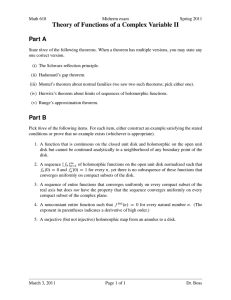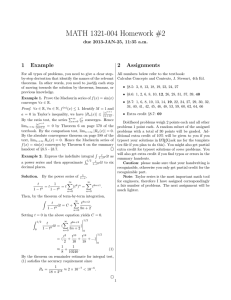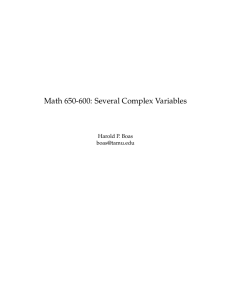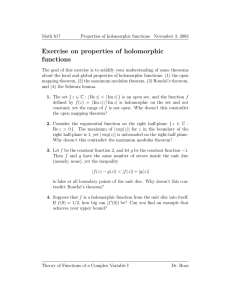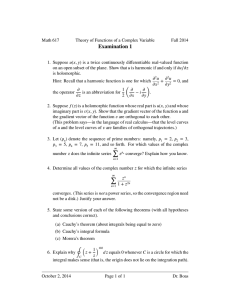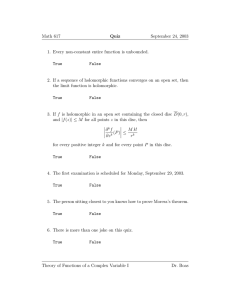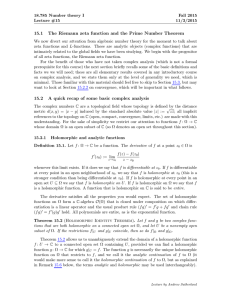Real & Complex Analysis Qualifying Exam Solution, Fall 2009 A-1 Shiu-Tang Li
advertisement
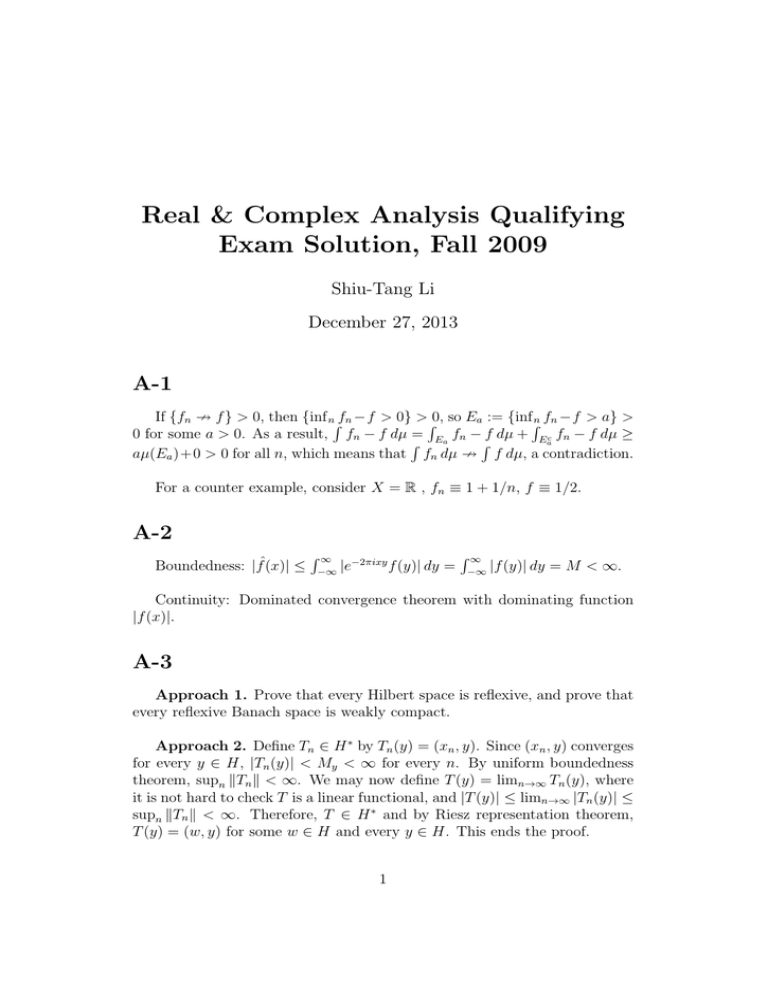
Real & Complex Analysis Qualifying
Exam Solution, Fall 2009
Shiu-Tang Li
December 27, 2013
A-1
If {fn 9 f } > 0, then {inf nRfn −f > 0} >R0, so Ea := {infRn fn −f > a} >
0 for some a > 0. As a result, fn − f dµ = Ea fn − f dµ + E c fn − f dµ ≥
a
R
R
aµ(Ea )+0 > 0 for all n, which means that fn dµ 9 f dµ, a contradiction.
For a counter example, consider X = R , fn ≡ 1 + 1/n, f ≡ 1/2.
A-2
Boundedness: |fˆ(x)| ≤
R∞
−∞
|e−2πixy f (y)| dy =
R∞
−∞
|f (y)| dy = M < ∞.
Continuity: Dominated convergence theorem with dominating function
|f (x)|.
A-3
Approach 1. Prove that every Hilbert space is reflexive, and prove that
every reflexive Banach space is weakly compact.
Approach 2. Define Tn ∈ H ∗ by Tn (y) = (xn , y). Since (xn , y) converges
for every y ∈ H, |Tn (y)| < My < ∞ for every n. By uniform boundedness
theorem, supn kTn k < ∞. We may now define T (y) = limn→∞ Tn (y), where
it is not hard to check T is a linear functional, and |T (y)| ≤ limn→∞ |Tn (y)| ≤
supn kTn k < ∞. Therefore, T ∈ H ∗ and by Riesz representation theorem,
T (y) = (w, y) for some w ∈ H and every y ∈ H. This ends the proof.
1
A-4
R
R
|T g| ≤ |f g| dµ ≤ kf k∞ |g| dµ = kf k∞ kgkL1 , which shows that T is
bounded. It is straightforword that T is a linear functional on L1 (X).
R To see kT k ≥ kf k∞ , consider g = sgn(f )χ{|f |>kf k∞ −} , and |T g | =
|f |χ{|f |>kf k∞ −} dµ ≥ (kf k∞ − )µ(|f | > kf k∞ − ) = kg |L1 (kf k∞ − ).
Since is arbitrary, the result follows.
A-5
Refer to the solution of A-1(b) in Spring 2010 qualifying exam.
B-6
Let g(z) := f (z)/z for z ∈ D \ {0}, and g(0) = f 0 (0). g is holomorphic on
D \{0} and continuous on D, so g is holomorphic on D by Morera’s theorem.
By maximum modulus theorem, |g(z)| = |f (z)|/|z| ≤ maxw∈∂D |g(w)| =
maxw∈∂D |f (w)| ≤ 1 for all z ∈ D.
If |f (z0 )|/|z0 | = 1 for z0 ∈ D \ {0}, or |g(0)| = |f 0 (0)| = 1, then maximum
modulus theorem tells us that g(z) is constant on D. In this case, f (z) = λz
for all z ∈ D, where |λ| = |f (z0 )|/|z0 | = 1.
B-7
(1 + z 2 )e1/z = (1 + z 2 )
Therefore,
Z
2
1/z
(1 + z )e
γ
P∞
1
n=0 z n n!
= z2 + z +
P∞
1
n=0 ( n!
+
1
) 1 ∀z
(n+2)! z n
6= 0.
Z X
∞
1
1
1
dz = (z + z) dz +
( +
) n dz
(n + 2)! z
γ
γ n=0 n!
∞ Z
X
1
1
1
=0+
( +
) n dz
since the series converges uniformly
n! (n + 2)! z
n=0 γ
Z
7
1
7
=
dz = πi.
6 γz
3
Z
2
2
B-8
See B-6 of Spring 2011.
B-9
Since f is holomorphic on r < z < R, f has Laurent series representation
about 0 (See complex analysis by Bak and Newman), that is,
P∞
f (z) = n=−∞ an z n . By assumption, for every n ≥ 0,
Z
Z
n
z f (z) dz =
0=
|z|=ρ
zn
|z|=ρ
=
∞
X
k=−∞
∞ Z
X
k=−∞
Z
=
ak z k dz
ak z n+k dz
since the series converges uniformly
|z|=ρ
a−n−1 z −1 dz = a−n−1 2πi.
|z|=ρ
an = 0 for every n ≤ −1, and we can write f as f (z) =
P∞This shows
n
R. The convergence of the series for r < z < R also
n=0 an z on
Pr<z <
n
a
z
converges
on z < r. Therefore, we can extend f to a
shows that ∞
n=0 n
holomorphic function on z < R.
B-10
See B-10 of Fall 2010.
3


